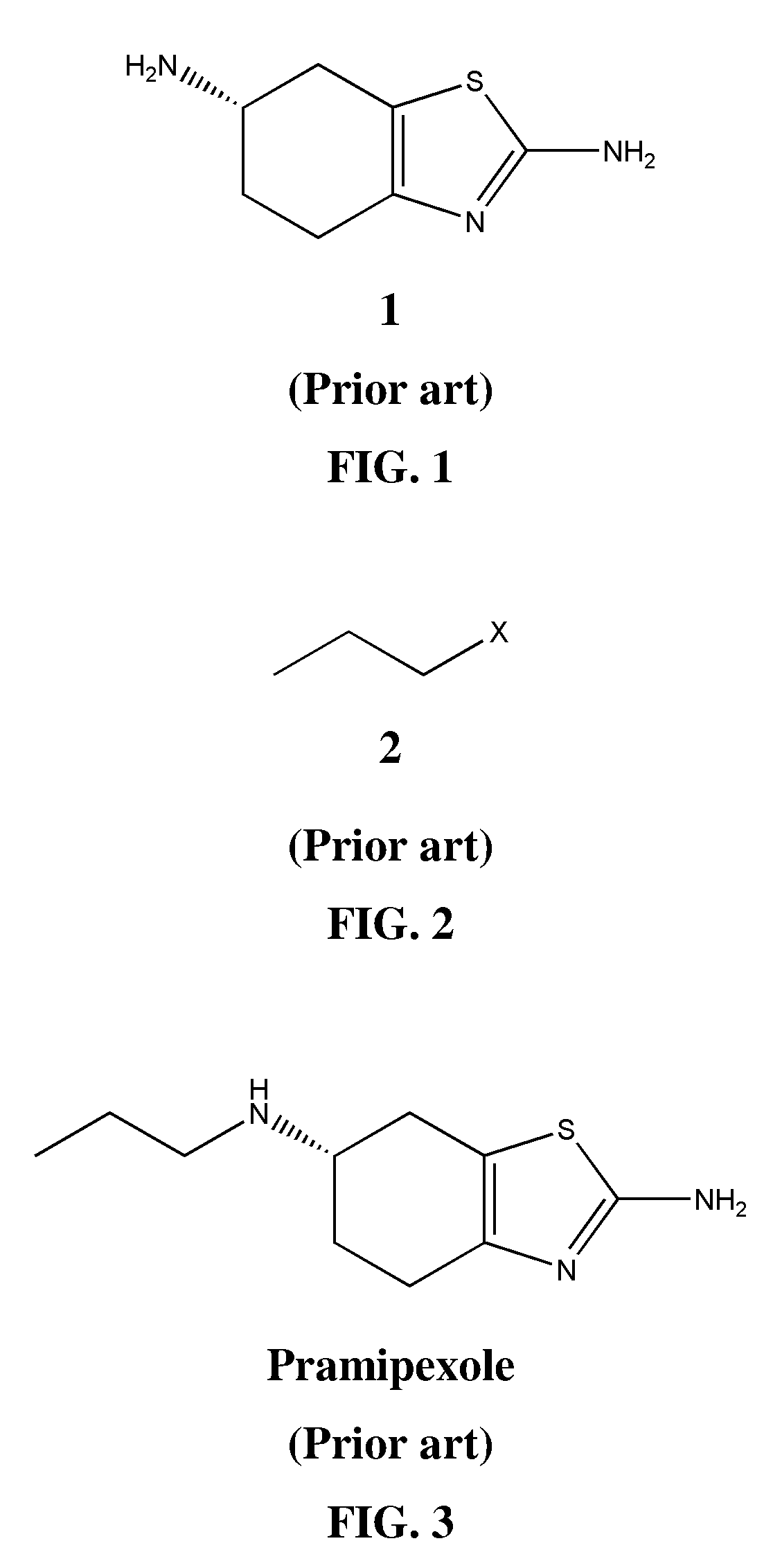Process for the preparation of pramipexole base and/or its salts
a technology of pramipexole and salt, which is applied in the field of process for the preparation of pramipexole base and/or its pharmaceutically acceptable salts, can solve the problems of large amount of anhydrous solvent, inconvenient procedure for large-scale synthesis, and inability to meet the requirements of large-scale synthesis
- Summary
- Abstract
- Description
- Claims
- Application Information
AI Technical Summary
Benefits of technology
Problems solved by technology
Method used
Image
Examples
example 1
(S)-(−)-2-Amino-6-n-propylamino-4,5,6,7-tetrahydrobenzothiazole, p-toluenesulfonate
[0058]The suspension of (S)-(−)-2,6-diamino-4,5,6,7-tetrahydrobenzothiazole 1 (10 g, 0.06 mole) and n-propyl p-toluenesulfonate (38 g, 0.17 mole) in N,N-dimethylformamide (100 mL) was stirred at room temp. for 96 h. Pramipexole p-toluenesulfonate was formed as cream-colored, crystalline solid, which was washed with propan-2-ol. Yield of the product after drying: 14.2 g (64%).
[0059]M.p. 253-5° C. (dec.), 1H NMR (DMSO-d6) δ: 7,11-7,32 (2d, 4H), 3,50-3,54 (m, 1H), 3,06 (t, 2H), 2,81 (s, 3H), 1,96-3,11 (s, 6H), 2,01 (m, 2H), 0,96 (t, 3H).
example 2
(S)-(−)-2-Amino-6-n-propylamino-4,5,6,7-tetrahydrobenzothiazole, dihydrochloride
[0060]a) Direct Method
[0061]Pramipexole p-toluenesulfonate (3 g, 0.008 mole) was suspended in propan-2-ol (25 mL). Concentrated hydrochloric acid (1.57 mL) was added portionwise. The mixture was stirred at room temp. for 0.5 h, then for 12 h at 5° C. White, crystalline solid of pramipexole dihydrochloride hydrate was filtered off. Yield of the product 1.48 g (67%).
[0062]M.p. 296-8° C.; 1H NMR (CD3OD): 3,68 (m, 1H), 3,10 (t, 2H), 2,00-3,28 (m, 6H), 1,95 (m, 2H), 1,06 (t, 3H).
[0063]b) Direct Method
[0064]To the solution of acetyl chloride (21.4 g, 0.26 mole) in propan-2-ol (20 mL) pramipexole p-toluenesulfonate (3 g, 0.008 mole) was added portionwise. The resulting mixture was stirred for 0.5 h at room temp., then for 12 h at 5° C. White, crystalline solid of pramipexole dihydrochloride was formed, which was filtered off. It was obtained 1.9 g (86%) of the title product, m.p. 297-298° C.
[0065]c) Indirect Me...
example 3
(S)-(−)-2-Amino-6-n-propylamino-4,5,6,7-tetrahydrobenzothiazole, hydrobromide
[0067]To the suspension of S-(−)-2,6-diamino-4,5,6,7-tetrahydrobenzothiazole (4.23 g, 25 mmole) in N,N-dimethylacetamide (50 mL) n-propyl bromide was added (12.3 g, 100 mmole) and the resulting mixture was stirred at room temp. for 72 h. A crystalline solid precipitated. It was filtered off and washed in a sep funnel with propan-2-ol (25 mL). After drying 5.82 g of pramipexole hydrobromide was obtained (yield 80%). The product was crystallized from acetone-water (7:3 v / v) solution. M.p. 257-259° C., water contents (Karl-Fischer)-0.2%.
PUM
| Property | Measurement | Unit |
|---|---|---|
| temperatures | aaaaa | aaaaa |
| temperatures | aaaaa | aaaaa |
| optical purity | aaaaa | aaaaa |
Abstract
Description
Claims
Application Information
 Login to View More
Login to View More - R&D
- Intellectual Property
- Life Sciences
- Materials
- Tech Scout
- Unparalleled Data Quality
- Higher Quality Content
- 60% Fewer Hallucinations
Browse by: Latest US Patents, China's latest patents, Technical Efficacy Thesaurus, Application Domain, Technology Topic, Popular Technical Reports.
© 2025 PatSnap. All rights reserved.Legal|Privacy policy|Modern Slavery Act Transparency Statement|Sitemap|About US| Contact US: help@patsnap.com



